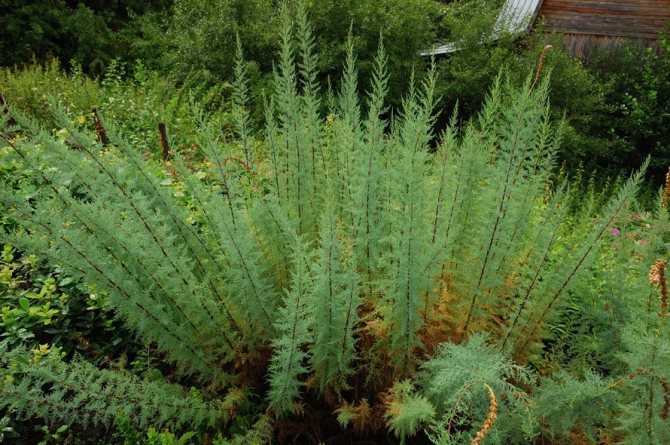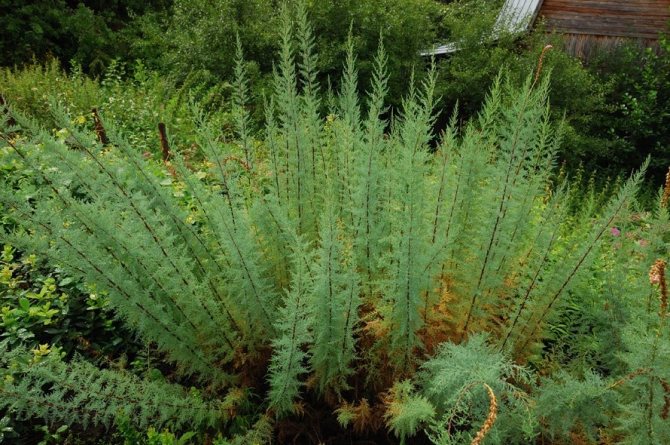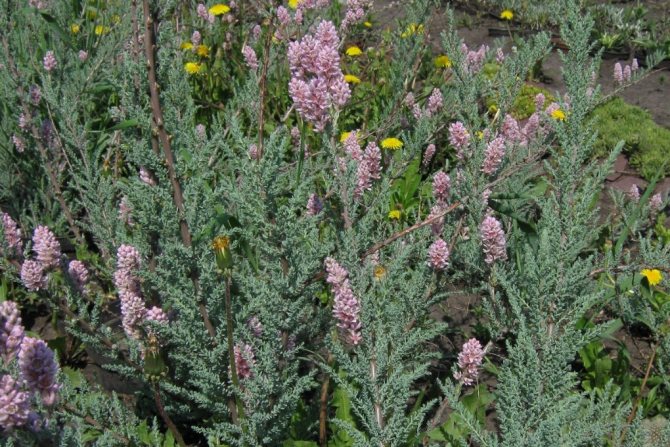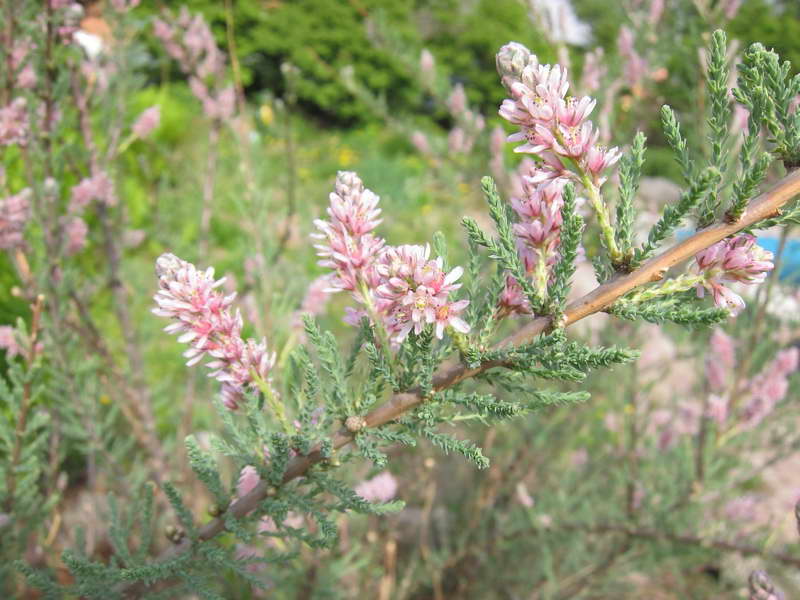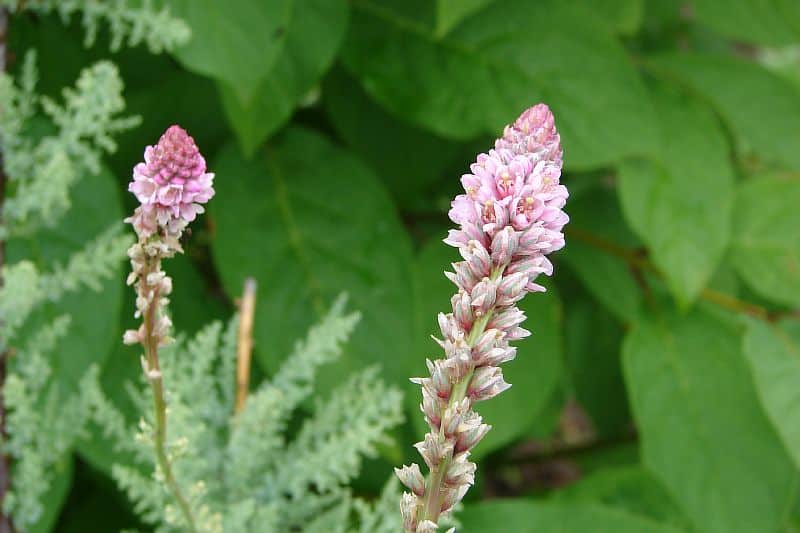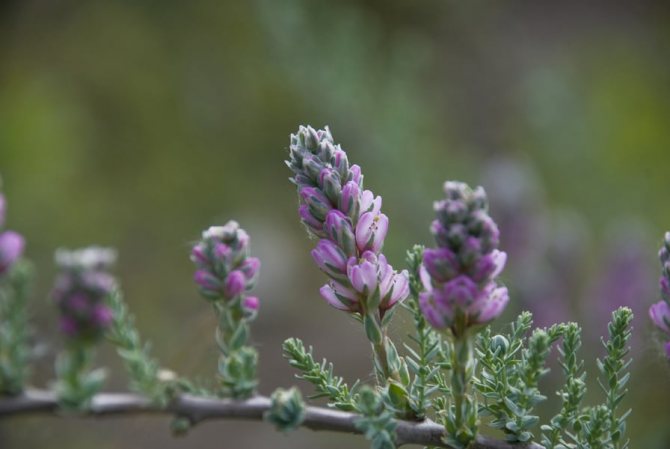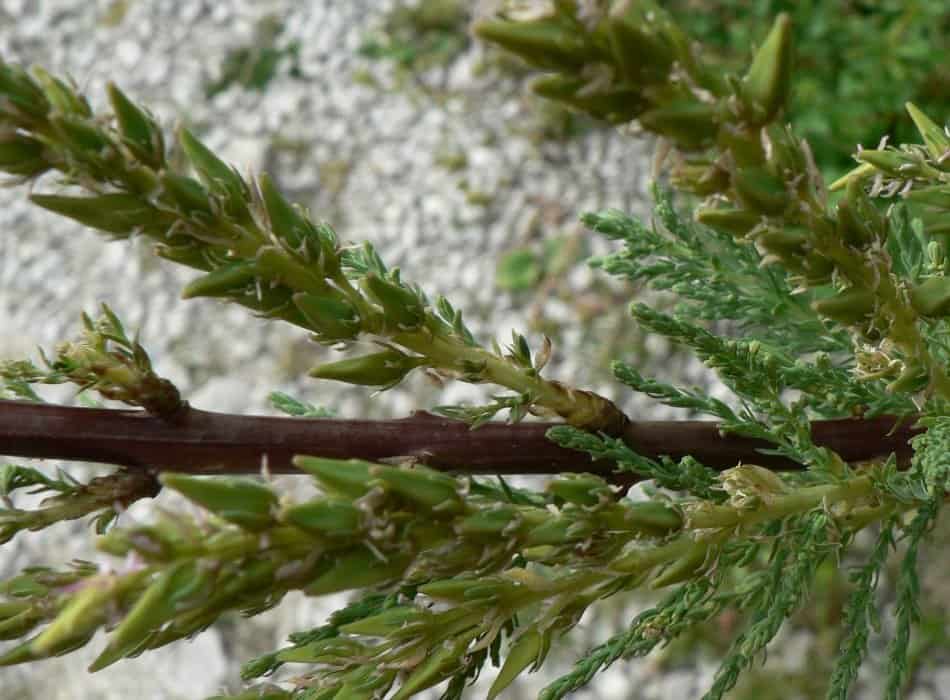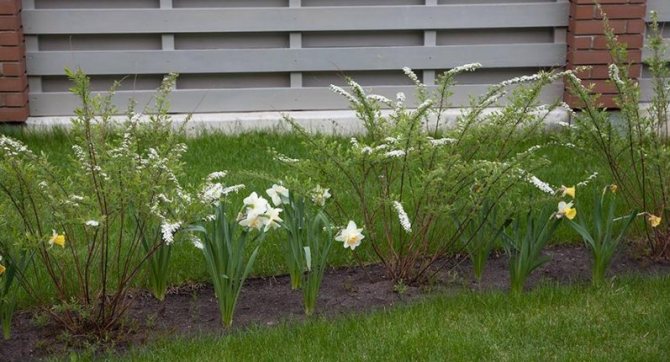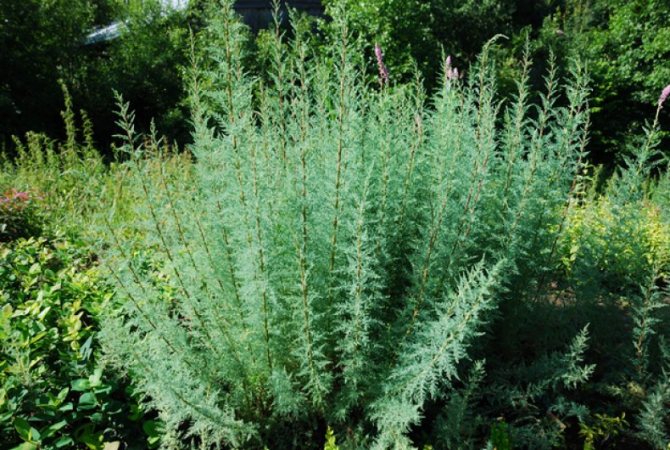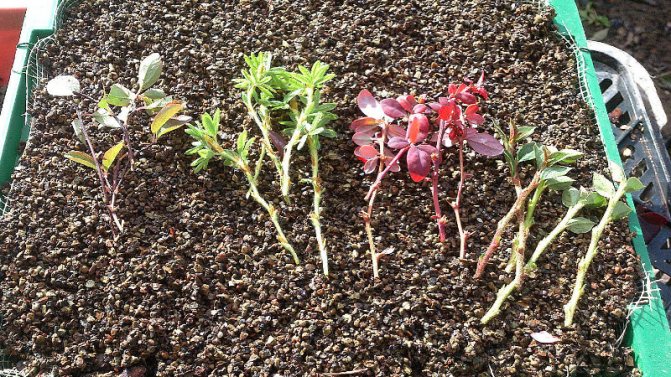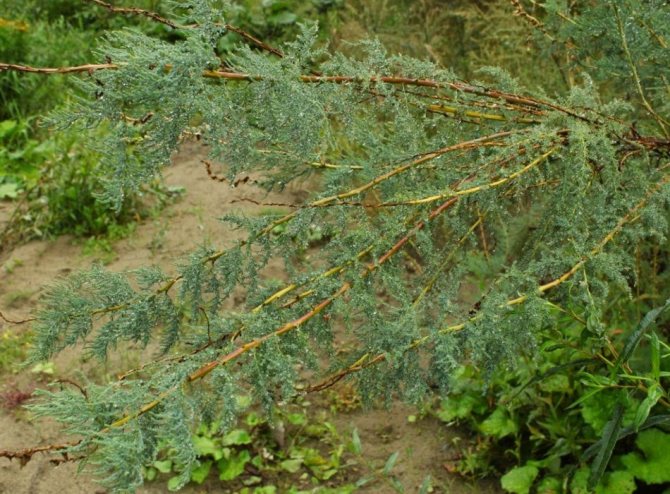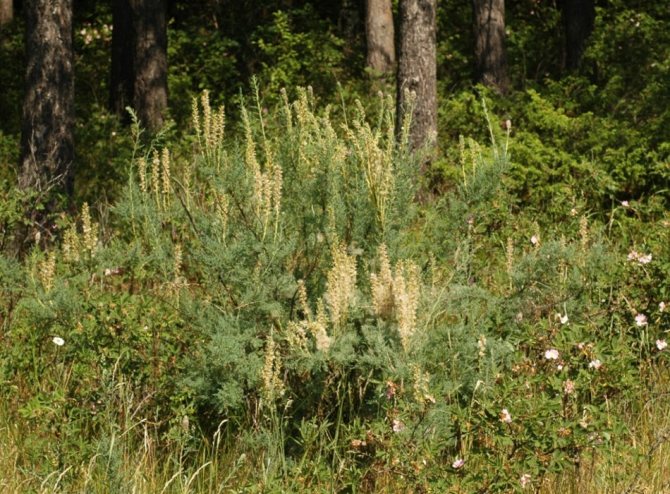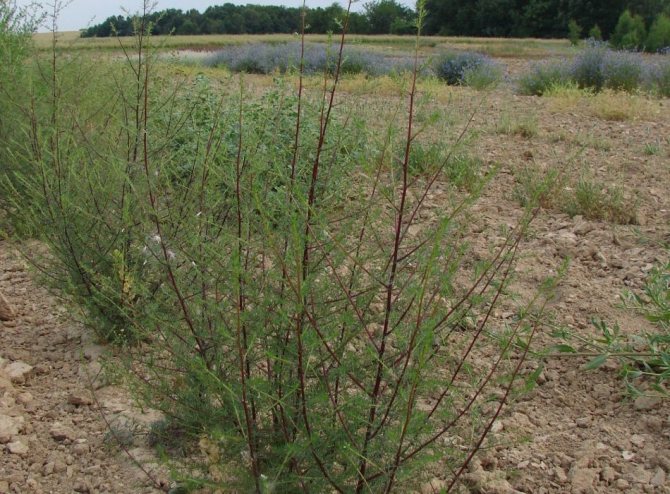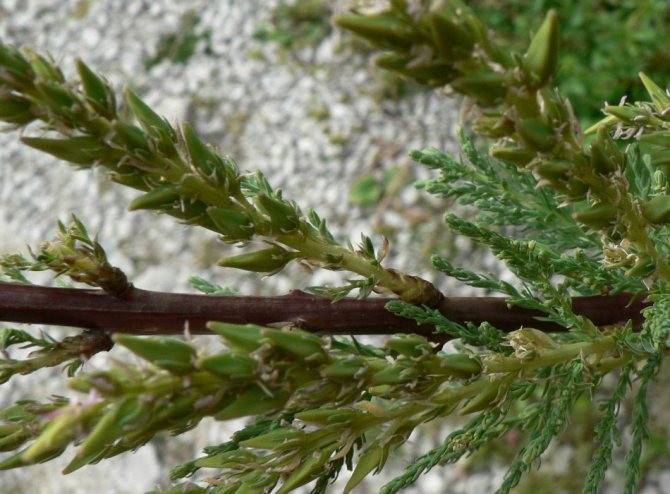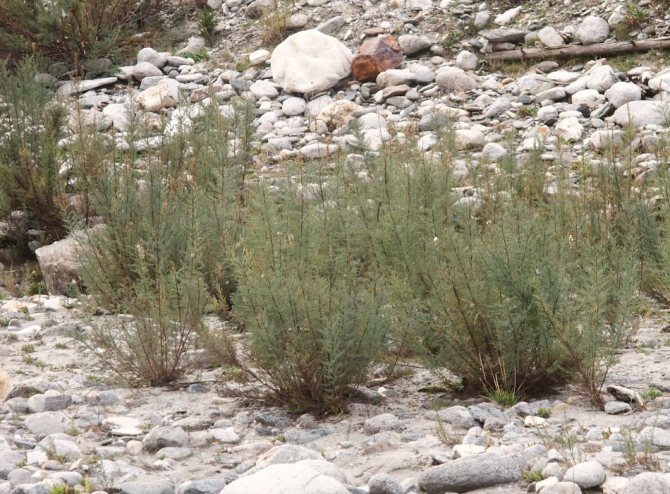22.07.2019
Myrikaria foxtail is a rare species that can reach a height of about two meters. Very well tolerated in extreme cold. Myrikaria has an interesting description. outwardly it is a sprawling bush with red or yellow-brown shoots. The leaves completely cover the twigs and have a peculiar scaly shape. Silver-colored leaf plates with a blue tint. Inflorescences are spike-shaped and pink in color.
Important!
The root system of myricardia is small, weakly rooted, therefore, on sandy stones, the bush will suffer from drying out of the upper layers of the soil.
Types and varieties of myrikaria
Of the 10 types of myrikaria, only 2 species are found in landscaping: foxtail with an apical inflorescence and Daurian with inflorescences that are located on lateral branches. These 2 species lend themselves well to recovery after winter damage, and thanks to their sophisticated appearance during flowering, they revive the monotony of popular deciduous shrubs.
Mirikaria daurskaya
Distributed in Eastern Siberia and Mongolia, where it grows singly or in groups on pebbles along rivers and streams.
Shrub 2 m in height, on old shoots with brown-gray bark and yellow-green on young ones. The leaves of myrikaria dahurian are gray-green, sessile on primary branches, infrequent, oblong-ovate, and on secondary branches - linear-lanceolate. Flower brushes, both apical and lateral, simple or complex, 10 cm long, lengthen during the flowering period.
Bracts broadly ovate, with a slight acumen. Calyx 4 mm long, slightly shorter than petals, calyx lobes widened towards base; petals of myrikaria daira pink, oblong-oval 6 mm long. Fruits are narrow capsules. The seeds are small, with an awn half-covered with white long hairs. Myrikaria daurskaya blooms from June to August, at the same time the fruits ripen.
Photophilous and winter hardy
... Propagated by cuttings, seeds and shoots from the stump. Mirikaria daurskaya is decorative thanks to its beautiful crown and green coloring of scale-like leaves. Recommended for hedges, as it tolerates a haircut perfectly.
Myrikaria foxtail
Under natural conditions, it grows in Western Europe, Siberia, Central and Central Asia, and the Middle East.
Myrikaria foxtail is a shrub with graceful, spreading shoots, covered entirely with alternate, fleshy, gray-green leaves. From May to September with small, numerous, pink flowers, collected in dense, almost spike-shaped, drooping inflorescences.
Flowers begin to bloom from the bottom of the inflorescence, gradually moving to the top. During flowering, the inflorescences of myrikaria foxtail lengthen 5 times, reaching half a meter. The fruits ripen at different times.
Myricaria multiplies
foxtail cuttings, seeds, shoots from the stump. Photophilous, resistant to pests. Grows well in well-drained, fertile areas.
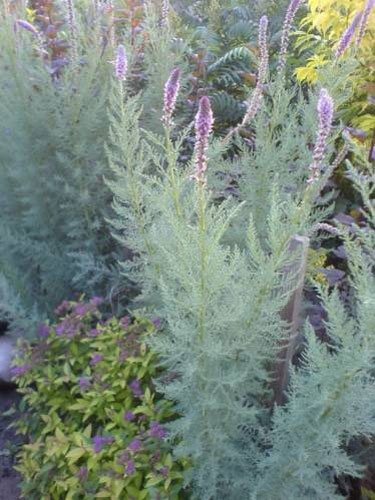
Tolerates haircuts well. Beautiful during the growing season. In the spring, it is recommended to feed it with a complex mineral fertilizer. Myrikaria foxtail can freeze to the level of snow cover and grows back over the season.
For the winter, you need to tie the shoots and tilt them to the ground.The shrub is suitable for planting in flower beds with tall perennial plants and near a reservoir.
I have long dreamed of making a real "wild" garden. Not with weeds, of course, but so that it does not turn out to be "licked" or artificial, but looks like a well-groomed forest.
Therefore, we do not have paved paths, alpine hills and pretentious rose bushes, but there is rockery, fragrant juniper thickets, paths lined with varietal hosts, and flowering thickets of myrikaria in the background.
This is a perennial deciduous shrub from the Tamarisk family (or Tamarix), the shape of the leaves of which resembles needles.
The plant can be recognized by:
- elongated yellow-brown, non-woody branches, growing up to 2 meters in height (and the bush spreads out 1.5 meters in width, since up to 20 shoots are quickly expelled from one root);
- scaly green (slightly bluish) leaves, completely covering each shoot;
- spike-shaped pink inflorescences.
This unpretentious plant looks rustic, but it winters very well, even if the frosts are strong, so myrikaria is an ideal solution for summer cottages for busy people.
The closest "sister" of the fox-tail can be called the Daurian myrikaria. Here is her photo for comparison:
In the wild, the "fox's tail" can be seen near rivers, in the mountains or forests of the Far East, Siberia, Kazakhstan, China. It grows well on rocky soils. In addition, the bush is not afraid of pests and typical flower diseases.
You will see more photos of this worthy plant here:
When this plant blooms
Flowering begins in May and ends as early as September.
Flowers in inflorescences do not bloom all at once, but in turn: first the lower ones, then the middle ones, and, finally, the tip of the inflorescence blooms. During this time, it significantly stretches in length, resembling a fluffy fox's tail (hence the name).
An even greater resemblance to the tail of an animal in a plant occurs in September, during the period of seed ripening - they slightly resemble dandelion seeds, since they also have fluffy "parachutes".
Like flowers, seeds ripen one at a time. They are located in a fluffy pyramidal box.
Varieties
In culture, two types of myrikaria are known:
- Daurian;
- foxtail.
She is long-leaved, often found in the south of Siberia and Altai. In the first year of life, young shoots are covered with a yellowish-green bark, which turns brown in subsequent years. The foliage is gray, narrow, reaching 5-10 mm in length, and only 1-3 mm in width. The shape of the leaves is oblong or ovoid, the upper part is dotted with small glands.
Inflorescences are formed on lateral (older) and apical (one-year) shoots. The shape of the inflorescences is simple or more complex, branched. At first, the peduncles are shortened, but become longer by the opening of the buds. On the bracts up to 6 mm in diameter, there is a miniature calyx, 3-4 mm in size. Pink oblong petals protrude 5-6 mm forward and are 2 mm wide. Half accrete stamens adorn the capitate stigma of the ovary. In a tricuspid elongated box, there are elongated seeds up to 1.2 mm in length with a partially pubescent awn.
Or, according to other gardeners, foxtail is more common in Western Europe, as well as in the Far East and Central Asia. Low shrubs with straight and ascending lateral shoots are strewn with successive fleshy leaf scales. The color of the leaf is silvery with a blue tint.
From mid-May to late August, the upper stems are decorated with clusters of pink inflorescences. Flowers densely cover the peduncle and begin to open from below, under the weight of the buds, the stem often descends in an arc. Until the buds open, the peduncle is about 10 cm long and resembles a dense bump, but, as it blooms, it lengthens to 30-40 cm and becomes looser.
At the beginning of autumn, fruit ripening begins.Due to the whitish pubescence of the seeds at the ends of the branches, large shoots resemble the tail of a fox with a lush light end. For this feature, the plant got its name.
Planting a flower
- Time. Although this plant is problem-free, it is worth worrying about planting it only when the growing season of the bush has not yet begun or has already ended, that is, either in early spring (until the leaves have blossomed), or in late autumn (when they have already dried up).
- A place. Myrikaria foxtail will grow well in a sunny, open, but cozy, draft-free area. It may be partial shade, but in this case fewer flowers will bloom.
- Priming. In the wild, this shrub willingly "clings" between stones. But in order for the bush to bloom beautifully, choose a slightly acidic or neutral, light, drained, fertile soil. It is good if it is wet loam (soil, the main composition of which is sand and clay). But even such land can be improved by digging it up with peat in advance.
- The dimensions of the pit. Dig 50 cm in width and depth.
- Landing actions. At the bottom of the pit, first lay the obligatory drainage (large stones, crushed stone or broken brick). Drainage layer - 20 cm. Further - soil, which can be enriched with "Nitroammophos" or wood ash. Place the seedling on top of the pile of earth, placing the root collar at the level of the ground line.
- Mulch. After planting, water the bush, and mulch the soil around it (this is not necessary, but in the future it will help to reduce the frequency of watering). The layer should be about 10 cm. Use humus, small tree bark or peat as mulch.
- The spacing between the bushes. It should be between 1 and 1.5 meters.
The peak of flowering of a young bush will come at the 4th year of life.
How such a bush multiplies
Myrikaria can be grown from seeds. This is not an easy way, since the seeds have low staleness, and if they are not stored correctly (in an unsealed package, overheating), they quickly deteriorate. Before sowing, the seeds must be stratified.
You can root the stalk much faster. It is cut in early spring or late autumn, the average length is 20 cm. Rooted in moist soil (garden soil + humus + peat + sand). The stalk is stuck into the ground at an angle. If you cut a couple of bottom cuttings in the summer, you can stick them directly into the flower bed, covered with a glass jar for insurance.
A bush grown from a cuttings will bloom already at 2 years of age. It is better for a rooted cuttings to overwinter their first year in the house, in a pot, and only in the second year, transfer it to the garden.
Also, the shrub reproduces by shoots from its own stump.
What decorative culture can fox-tailed myrikaria be "friends with"
In landscape design, the shrub can be used both in a solitary (single) planting and as the main eye-catcher in a flower bed. Plant it in a "bundle" with plants that have leaves of juicy green shades, and the bluish leaves of myrikaria will contrast with them in an original way.
Mirikaria will love growing near the pond. If the slopes of the pond are problematic (crumble), the deep roots of the bush will also strengthen them. In addition, the plant can be beautifully beaten when creating an alpine slide, rockery, as a border. The pseudo-coniferous bush looks best in combination with stones.
You can combine the bush with similar plants - green, decorative deciduous (conifers, ferns, euonymus) or bright flowers, which will create a slight contrast to the bluish leaves and pink myrikaria flowers (periwinkle, roses).
And in order not to spoil the garden "a la nature", plant another simple flower near myrikaria, but with a different shade - tenacity.
Transplanting a flower
The established bush can be transferred to a new place at least 2 years later.
Use the transshipment method without shaking off the stuck earthen lump from the roots at all.
Myrikaria is transplanted in early spring or late autumn, when the foliage on the bush has not yet blossomed or has already crumbled.
Propagation of myrikaria by cuttings
- For cuttings, you can take both old woody shoots and young annuals.
- The length of the cutting should reach 25 cm, the thickness of the lignified stem should be about 1 cm.
- A freshly cut cutting should be immersed in an aqueous solution of a growth stimulant (Epin, Kornevin, etc.) for 1-3 hours.
- Treated cuttings are planted in pots with soil under cover from jars or plastic bags.
- Roots are quickly formed and the plant will soon be ready for planting in open ground, but in the first year of life, myrikaria is extremely sensitive to frost. For this reason, it is better to plant seedlings in open ground in the spring of the second year, without fear of subsequent wintering.
Reproduction by dividing the bush and layering
You can divide the bush in early spring, before the start of sap flow. Carefully dig in on one side and cut off part of the bush. Planted in the usual way, maintaining the planting level and straightening the roots.
To get a layering, bend the twig, pin it to the ground and sprinkle it with earth. Special care is not required: after a while, the branch will take root in the place of powder, and after two seasons the seedling can be separated from the mother bush and planted in a new place.
Basic principles of care
Mirikaria is a plant that can be planted for many years. You do not have to fight pests or treat a shrub for flower diseases, since it is resistant to them.
Watering
Although the bush tolerates a short-term drought, it is inherently moisture-loving. Even if there is stagnation of water near the roots (short-term), the bush will not get sick because of this.
Water myrikaria every week, giving 10 liters per plant (a young bush needs a little less water). Reduce watering if the week is rainy.
I like to water the shrub with a hose by spraying it. I noticed long ago that the more humid the microclimate, the better myrikaria blooms.
After some watering, it is worth to loosen the soil around the bush. After that, you can update the mulch layer. If there is no mulch, you can loosen the soil after each watering.
Food
You can feed the bush from spring to summer, applying both organic matter and mineral fertilizers.
- April May. Dig up the bush shallowly with 10 liters of compost or humus, and 2 weeks later, mulch the near-trunk soil with peat or wood chips. Or: buy a mineral complex for heather crops for myrikaria.
- Summer. Prepare a nutritious watering by diluting herbal infusion or liquid mullein (but give water at least 10 parts per part of the food, because if the solution is too concentrated, you can burn the roots and kill the plant). Pamper the bush with this watering once or twice over the summer.
Pruning
Of course, your shrub may look quite loose - spreading, like Mother Nature "gave birth". But most people like it when it is trimmed and given a ball or other neat shape.
Pruning and pinching foxtail myrikaria is needed constantly.
- Start forming the crown immediately after planting, in the first summer of the bush's life, spending frequent pinching. By autumn, the branches of such a plant will not grow longer than 50 cm, but they will be lush.
- In the fall, do not touch the shrub so as not to weaken it before wintering.
- Perform a health check next spring to remove unsightly, dry, broken branches. At the same time, adjust the shape of the crown to the ideal. This should be done every year. The bush tolerates it well.
Preparation for wintering
You do not need to cover this bush - it will not freeze out, even if your thermometer drops below 40 degrees in winter.
However, it will be correct if you tie the branches of myrikaria in the form of a sheaf and bend the bush to the ground, fixing it with a peg. This will protect the shoots from breaking off due to heavy snow.
Snow covered, the bush will be safe. The branches sticking out above the snow "cap" may freeze (they will dry up by spring). Just prune them and the bush will grow new ones.
Description
Photos of myrikaria:
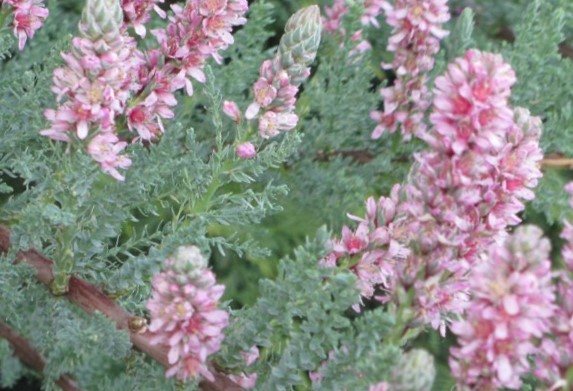

Heights a little more or less than a meter, spreading by the same amount, with shoots coming from the base of the bush and tiny fleshy blue leaves-scales, it is very attractive at any time of the summer season.
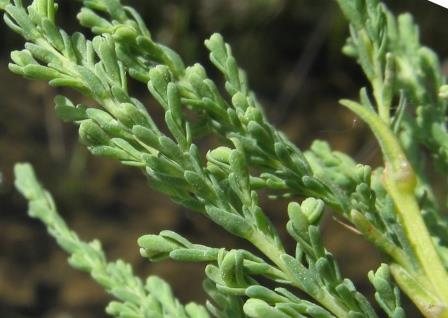

And when she dissolves tassels of flowers at the ends of the shoots, she is doubly beautiful. Flowering lasts from May to early August, all intensifying due to the growth of axillary shoots. Small flowers are crowded together, forming dense "spikelets", which by autumn turn into fluffy panicles from seeds - hence the name - foxtail myrikaria. Sometimes branches are strongly bent by the weight of inflorescences and rains, some support is needed.


To summarize ...
- Myrikaria foxtail is a garden flower of the most unpretentious. It perfectly tolerates winter frosts, is not picky about the soil.
- This shrub can be planted in early spring or late autumn.
- Caring for a flower is watering, infrequent loosening of the soil (the roots of myrikaria must breathe), spring-summer dressing. Do not forget about pruning - without such a procedure, the bush will grow to the sides and will look sloppy.
- This plant propagates by seeds and cuttings (more common method).
And what does the main relative of myrikaria, tamarix, look like? You can get acquainted with this garden plant in this video:
Myrikaria foxtail is a rare species that can reach a height of about two meters. Very well tolerated in extreme cold. Myrikaria has an interesting description. outwardly it is a sprawling bush with red or yellow-brown shoots. The leaves completely cover the twigs and have a peculiar scaly shape. Silver-colored leaf plates with a blue tint. Inflorescences are spike-shaped and pink in color.
Important!
The root system of myricardia is small, weakly rooted, therefore, on sandy stones, the bush will suffer from drying out of the upper layers of the soil.
Using
Mirikaria will serve as a beautiful addition to the design of natural and artificial reservoirs. It is used as a tapeworm or in group plantings in flower beds. Preferably the neighborhood with deciduous and coniferous dark green crops, as well as in the rose garden.
Myricaria has scaly, small leaves, like heather.
The genus Mirikaria has about 10 species growing in Europe and Asia.
Mirikaria is a shrub with yellow or reddish-brown shoots and ordinary, scaly leaves that completely cover the shoots. The flowers of this shrub have a long bracts, the fruit is a box with seeds, equipped with hairy awns at the very top.
Mirikaria is a light-loving and moisture-loving shrub. Gives good growth from the stump. Tolerates haircuts well. The shrub is decorative with its extraordinary appearance during flowering and fruiting. For decorative purposes, it is used in single planting and hedges.
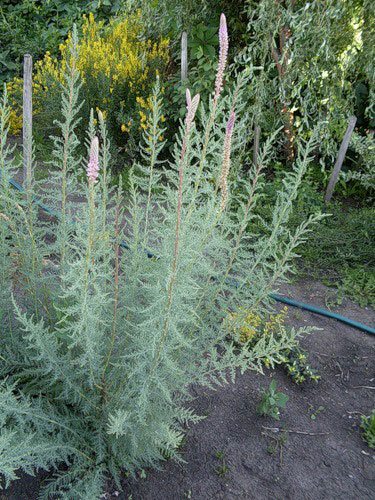

Features of planting bushes
For planting, you need to prepare pits with a diameter and depth of about 45 cm. Those plants that have reached the age of two take root better. When planting, you need to adhere to a distance between the bushes of about 1.5 m, since they grow very wide in width.
It is important that the root collar is level. If the soil is not at all fertile, you can use a mixture of coniferous earth and sand.
On clay soils, it is better to make from pieces of brick and sand, and lay out a layer of about 20 cm.
Mirikaria: habitat
The exotic appearance of the plant is enhanced by its unpredictable character. Its flowers bloom unexpectedly and gradually stretch out into long inflorescences, reminiscent of fiery fox tails (hence the name of the bush).
There are about ten varieties of myrikaria in nature, and they grow in Eastern Europe, as well as in Central Asia, Mongolia and the Himalayas, in the Pamirs and Altai. "Lives" in river valleys, on rocky-sandy shores and pebbles. Mirikaria can also be found in the mountains, at an altitude of 1900 meters.
Myrikaria foxtail: features of care
This shrub will be the best choice for those who do not like or do not have the opportunity to care for plants, but want to be beautiful. Mirikaria is very resistant to diseases and therefore the process of caring for it is not difficult.
Did you know?
Not all plants have scale-like or narrow-linear leaves, but only those living in temperate latitudes of the earth. In conifers, which were formed in a subtropical or tropical climate, the leaves are lanceolate.
Watering
To ensure abundant flowering of the shrub, it is necessary regularly
... If there is no rain at all, then this should be done once every two weeks, using 10 liters of water per plant. The frequency of watering depends entirely on the weather conditions and the level of dryness.
Loosening and mulching the soil
To ensure the rich color of the leaves, you need a shrub every spring. For this, it is necessary to apply, such as humus and.
And also in the summer you can bush about twice, for example, with infusion or fermented herbaceous infusion. With strong compaction of the soil around the bush, it must be shallowly loosened.
A haircut
needs to
... If you do not carry out this procedure, after 7-8 years the shrub will stiffen and lose its beautiful appearance.
You need to prune the plant twice a year. Spring trimming involves pruning frozen and dead twigs, and in the fall, the plant is given a decorative shape.
Wintering
Although this one is winter-hardy, you still need to prepare it for the cold weather. The branches can break from the weight, so they need to be tied. If the plant is still young, then it is bent to the ground.
Plant care
Mirikaria is not damaged by various diseases and is resistant to pests. She is very unpretentious. Easily tolerates winter frosts down to -40 ° С and summer heat up to + 40 ° С.
Fertile garden and loamy peat soils are suitable for planting. Prefers a neutral or slightly acidic environment. Mirikaria is resistant to drought, even in the heat it is enough a little watering, but on moist soils it grows and blooms more strongly. In the absence of rain, 10 liters of water per bush is enough once every two weeks. Withstands excess moisture and temporary flooding of the soil.
With the annual mulching of the soil with organic matter (peat or humus), the color of the petals and greenery becomes richer. During the season, you can make 1-2 feeding the bush with universal fertilizers for heather crops.
Slightly shaded areas of the garden are best suited for planting. The plant can tolerate bright light, but the midday sun can burn young shoots.
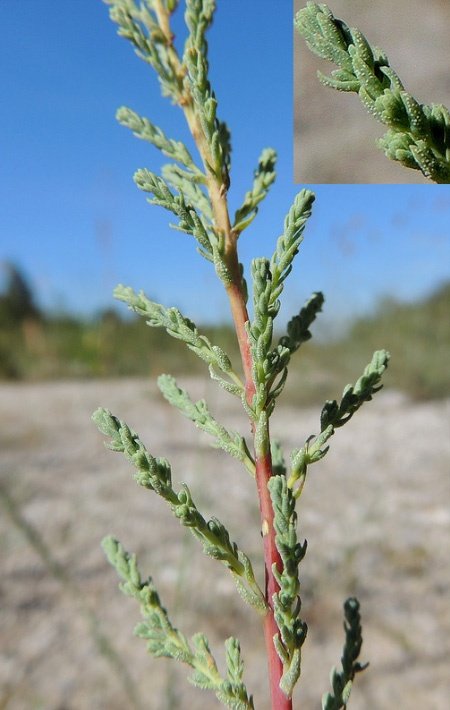

Gradually, the bushes are greasy, woody, at the age of 7-8 years, the plant significantly loses its attractiveness. To avoid this, you need to carry out regular pruning. It is performed in two stages:
- in the fall - for decorative purposes;
- in spring - to remove frozen and dry branches.
Spreading branches are vulnerable to strong winds, so they need special shelter or planting in calm places. In winter, the plant is tied up to help withstand snow drifts or strong gusts of wind. Young shoots can be bent to the ground in autumn.
Propagation by cuttings
Best of all, foxtail myrikaria takes root during reproduction. They are harvested in summer, during the period of mass flowering. To do this, you must cut the stems of the lower part of the plant. Then lower them for 1-3 hours in a water-alcohol solution
Myrikaria foxtail is a rather large shrub, numbering about 10 species. Geographically located in Central Asia and Eastern Europe, the Himalayas and Mongolia, as well as Altai and the Pamirs.It takes root easily in mountains and river valleys, on rocky and sandy lands. Lives both a wild-growing representative and a garden culture.
Description
Myrikaria foxtail - it is an upright shrub
... On average, it grows from the roots from 10 to 20 branches.
The uniqueness of this species is given by the leaves, which have an interesting scaly shape and color. Tightly sessile to the stem, openwork, bluish-green in color, give an exotic look to the plant.
In May on this bush
many bristles appear, similar to mauve spikelets. It blooms from bottom to top with small flowers that live from 3-5 days. This period is quite long and is up to two months. The stems do not grow stiff, and because of this, experts classify this species as semi-shrubs.
Reproduction
When propagating by seeds, it is necessary to observe the conditions for their storage, as they quickly lose their properties. Keep seeds at moderate temperatures in a sealed, waterproof package. Landing is done next year. Before sowing, seeds are stratified for a week in a refrigerator at a temperature of + 3 ... + 5 ° C. After such a procedure, the germination rate exceeds 95%. Only a third of the seedlings will grow without stratification.
Seeds are sown in boxes without deepening or sprinkling with earth. Drip or ascending method of soil moistening is preferable. Already on day 2-3, the seeds hatch and a small root appears. A ground shoot is formed in about a week. Fortified seedlings are transplanted into the garden after the onset of stable heat, since the slightest frost will destroy the plants.
It is more effective to propagate myrikaria by cuttings and dividing the bush. For these purposes, old (woody) shoots and young (annuals) are suitable. Cuttings can be cut and rooted throughout the growing season. Their length should be 25 cm, and the thickness of the woody stems should be 1 cm.
Freshly cut cuttings are immersed for 1-3 hours in a water-alcohol solution of growth stimulants (Epin, Heteroauxin or Kornevin). Planting immediately is best done in prepared pots or plastic bottles. Although the roots form quickly and the plant is suitable for planting in open ground, its sensitivity to frost in the first year of life is very high. In cold climates, young shoots do not winter well. But in the spring of the second year, they can be safely planted in the garden and not be afraid for future wintering.
Planting, pruning and caring for foxtail myricaria
It is quite easy to take care of the plant; it will not be difficult for novice gardeners. The whole process is to loosen, fertilize and prune in time to form a bush to avoid disease.
Mirikaria is a grateful plant and responds to decent care with rapid growth and abundant flowering.
An interesting variety withstands up to minus 40 ° in winter, up to plus 50 ° in summer.
Feels great in any area. Planted foxtail myrikaria in the shady side and in the sun will differ from each other only by the difference in flowering. The plant is undemanding to the composition of the soil, fertile or loamy soils do not affect the splendor of the bush.
Satisfied with low irrigation. In the summer, dry time water once every 2 weeks with about 10 liters of water
... Loves light spraying. In case of flooding the place where myrikaria grows, it will not die and will calmly endure a temporary flood.
Fertilize twice a year. Organic matter, humus, peat are added. In the spring, feed with growth stimulants.
Small shoots of Mirikeria and Tamarin are similar
, when buying a seedling, you need to be careful not to confuse it, since the second plant needs special preparation before wintering.
Myrikaria foxtail is a rather frost-resistant species. In frosty seasons, it is not subject to significant freezing, but this does not affect the general condition in any way. Does not require additional cover.In order not to break off the shoots, experts recommend tying the bush, and bending the young plant closer to the ground.
Planting occurs in the spring before foliage appears and in the fall (October). It is advisable to leave the soil on the roots when transplanting for better engraftment and strengthening. Fill the pit with natural fertilizers in the form of peat and ash.
The foxtail myrikaria propagates by cuttings and with the help of grains. If you decide to raise a plant from seeds, then you must follow the rules of collection, otherwise they will lose their ability to germinate. Before planting, put them in a refrigerator at a temperature of 1 to 5 ° C for 3-5 days, if this is not done, then the germination rate will be about 30%, and having made stratification, the chances increase to 95%.
It is much more convenient to plant a bush with cuttings. For this, branches are harvested
after flowering in summer. Then they are planted in containers filled with earth, peat and sand in equal proportions.
It is not recommended to cut the shoots before winter. because of the liquid of the myricaria bush, the foxtail can thoroughly weaken and freeze out.
Pruning is carried out before foliage bloom. Sick and frozen branches are removed. Carries a haircut at any time and several times. A bush is formed from an early age, the shoots are pinched, preventing them from growing more than 50 centimeters. If you cut off the overgrown branches throughout the summer, then by September the bush begins to acquire the shape you need. At the beginning of autumn, leave the plant alone in order for it to strengthen. Next year myrikaria
will become more luxurious and with an already formed bush.
A self-standing blue-green plant on a clipped alley will look original. Landscape designers
they combine myrikaria with spruce compositions; with small dense leaves, it looks like evergreen representatives. Landing along curbs and among stones will revive the silent neighborhood, decorate the shores of any body of water.
Shaping and pruning
Often the ends of myrikaria branches do not ripen by the end of summer, and in winter they freeze slightly. This is not dangerous. In the spring, such shoots should be pruned to healthy tissue. Cut off dry branches. and too long are shortened to achieve greater decorativeness.
The formation of the myrikaria shrub should be started "from childhood", pinching the tips of the shoots, observing the desired height. By trimming the tips as they grow, you can get the shape of a dense hemisphere or another. An important condition is that cutting and pinching by September must be stopped so as not to weaken the plant before wintering.
Pruning is also necessary for aged myrikaria, while shoots older than 7-8 years are cut on a "stump".
Secrets of Mirikaria Daurskaya
The procurement technique is simple. Chopped shoots are dried in the sun, and then dried in dryers. The finished branches are stored at room temperature in paper packaging.
Before using myrikaria daurian, a mandatory consultation with a doctor.
Preparation of infusion:
- 1 teaspoon of leaves;
- 200 ml of boiled water.
The broth is kept for 2 hours, filtered and used in 2-3 tbsp. spoons before meals three times a day.
Broth:
- 1 tsp leaves of myrikaria daurian;
- 250 ml of water.
Bring to a boil and cook for 5 minutes, close hermetically and leave for 1 hour. Drink one fourth part three times a day.
To prepare a bathroom you will need:
- 0.5 hot water;
- 2 tablespoons myrikaria.
Everything is boiled, then filtered and added to the bathroom. Receive a treatment procedure for 15–20 minutes. Good for joint pain.
Myricaria plant
Myrikaria foxtail is an interesting plant for landscape design, although it cannot boast of a variety of varieties. Some gardeners have only seen her in the photo, although both cultivation and maintenance require a minimum of effort. It is not difficult to propagate it, the main thing is to choose a successful landing site. Read about all this in the article.
Foxtail myrikaria: description
Externally, the myrikaria shrub is a sprawling bush that consists of low-branched erect shoots. They extend from the root in the amount of 10-20 pieces. The leaves of the plant are delicate, very small, densely sitting on the shoots. They look like bluish-green fleshy scales. It is the spectacular gray color of the leaves that distinguishes foxtail myrikaria as a bright spot among ordinary greenery.
From about mid-May, a large number of mauve flowers gradually appear on the bush, which, growing, form spike-shaped long inflorescences. The first of them bloom in the lower part of the bush, gradually moving to the top.
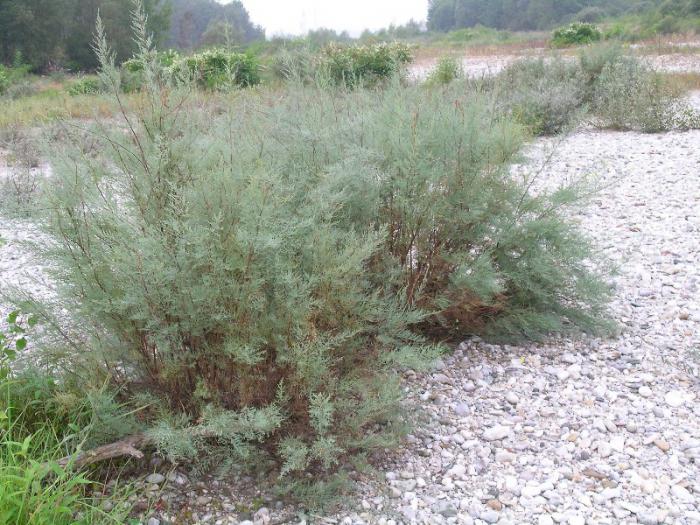

The flowering period of myrikaria lasts about 2 months and lasts until early August. The life span of a flower is 3-5 days. It is noteworthy that the ends of the shoots of this plant never become woody, so scientists attribute myrikaria to shrubs.
Varieties, features of myrikaria
Mirikaria from the genus of tamarisk has 10 species, which are both shrubs and semi-shrubs. For landscaping, 2 winter-hardy types are used:
- foxtail;
- Daurian.
The first of them is especially popular. Its natural range is very wide - spreading bushes can be found in the west of Europe, and in Central, Central Asia, and in the southern part of Siberia, and in northern Africa. Myrikaria's appearance is unusual in all respects, looking at the photo you do not immediately understand that this is not a representative of some exotic conifers, but a flowering plant with inflorescences and leaves of an original shape.
Flowering myrikaria bush
The foxtail myrikaria in our conditions grows up to 1.5 m. The bush forms up to 20 densely leafy shoots resembling a whip. Its bluish-green scaly leaves stand out against the background of the usual garden plants. Very decorative from the beginning of May to October, when it is covered with purple flowers, and later with fluffy fruits.
Main characteristics of myrikaria
The perennial plant belongs to the comb family and looks like heather. Its name is a word form of the Latin name for heather (mirica). The homeland of myrikaria is Asia (from Tibet to Altai), it is widespread in the Chinese and Mongolian plains. It also lives on plateaus and hills, climbing up to 1.9 km above sea level.
The shrub has reddish or yellow-brown branched shoots with miniature leaf scales. Low spreading shrubs in temperate climates reach 1-1.5 m, although in nature there are plants up to 4 m in height. The width of the garden representatives is 1.5 m.
In the bush, there are 10-20 main ascending shoots, smooth with a stiff structure. Lateral short branches are covered with small fleshy leaves, the color of the leaf plates is bluish-green. The growing season of the plant lasts from early May until frost. At this time, even without inflorescences, it serves as a decoration for the front garden or garden.
Myrikaria blooms in mid-May and pleases with delicate buds for two months. Such a long flowering is due to the gradual disclosure of flowers. First, they bloom on the lower shoots adjacent to the ground, and at the end of summer - on the tops of the plant. A single flower lives from 3 to 5 days. On long peduncles up to 40 cm in height, a spike-shaped inflorescence is formed. Depending on the variety, flowers form at the tops of the stems or in the leaf axils. The brushes are densely covered with small pink and purple flowers.
After flowering, the seeds ripen. They are collected in an elongated pyramidal box. The smallest seeds have whitish pubescence.
Features of planting and care
Mirikaria is a picky plant. Soil fertility does not play a big role for her. Ideal growing conditions are a sunny location, sheltered from the wind, with loamy, moist soil. In partial shade, it also grows, but much less flowers are formed on it.It is better to replant in the spring before the leaves appear or in October. A two-year-old bush with a large lump of soil takes root painlessly.
Mirikaria is completely undemanding to the landing site and the type of soil
The transplant is performed according to the following plan:
- Dig a hole 0.5 x 0.5 x 0.5 m.If several specimens are planned to be planted, then the next place is removed at least 1 m.
- Prepare the substrate by mixing light or medium loam with peat in equal quantities, and fill the seat with it. Additives in the form of 0.3 kg of ash or 50 g of a fertilizer mixture (NPK) will not interfere. If the earth is clay, then drainage is preliminarily arranged with a thickness of 0.15 m.
- A bucket of water is poured into the pit.
- Plant the plant, leaving the root collar at ground level, and mulch the soil around it.
Advice. In order for the bush to winter well, the branches are tied, otherwise they may break under the weight of the snow. Young bushes tilt and cover slightly.
Myricaria care includes weekly watering, loosening, mulching, crown formation. After wintering, you should prune shoots damaged by frost to healthy tissue. In its natural state, the bush is not compact, so only pruning can give the plant a neat appearance.
To give the bush the required shape, pruning is carried out
The formation of the crown begins at an early age, by pinching the green tops of the shoots throughout the summer, preventing them from growing by more than 0.5 m.When autumn comes, pruning is stopped, otherwise the plant will not have time to gain strength for wintering. If the procedure is carried out annually, then the bush takes the form of a bluish-blue hemisphere.
Attention! Be careful when buying seedlings. There is a plant that looks very similar to myrikaria - tamarix, some species of which require special preparation for the cold winter.
Care features
Look at the photo of the foliage - beautiful, unusual, fleshy - it is immediately clear that the shrub requires a lot of moisture and grows better near water bodies. True, when planting, it is necessary to lay drainage at a depth of about half a meter, fill the hole (50x50) with a clay mixture with peat, adding a handful of complex fertilizer or a glass of ash. Mirikaria tolerates almost any soil, but it is better to put clay in sandy soil.
Planting is preferable in the sun, as myrikaria blooms more strongly.
The best option is to plant out of a container, since the leaves of the shrub are sensitive to the slightest loss of moisture. If the root system is open, we plant it in early spring, when there is still no greenery, or in late autumn with a large lump of soil.
After the trunk circle, we mulch with humus, pebbles, wood chips, coniferous litter in order to maintain moisture and improve the composition of the soil under the mulch. Weeds weeded out would also do, but myrikaria decorates the garden, is often used in landscape design, and lying weeds, alas, are not suitable for this purpose.
Care during the summer consists in abundant watering and rare dressings. The interval between waterings is two weeks. If the summer is hot, we look at the state of the leaves, with a lack of moisture they dry out, wither. This means we water more often.
In the first half of summer, we feed a couple of times with a liquid infusion of mullein (1:10), by the end of summer we add ash to the soil.
How to fertilize and what to feed
Myricaria responds to fertilization and feeding with long flowering. In the spring, no later than May 15, humus or compost is introduced under the bush at least a bucket and shallowly embedded in the soil. After 14 days, the root zone is mulched using a mulch containing humus: crushed tree bark, peat. In the summer, myrikaria is fed 1 to 2 times with infused mullein, adding 1 liter to 10 liters of water. A good substitute for mullein is the following infusion:
- in a barrel with a capacity of 200 liters;
- spring ash - 1 shovel;
- manure or droppings - 0.5 buckets;
- dry leaves or rotten straw - 1 bucket:
- compost or garden soil - 1 shovel;
- milk whey - 1 l;
- mash made from 3 liters of water with the addition of 5 tablespoons of sugar and 100 g of yeast, fermented for 3 days.
This drug is infused for 7 days, then diluted with water in a ratio of 1: 2 and poured under each plant, 2 liters.
Feeding myrikaria with organic fertilizers
Planting conditions for myrikaria
Myrikaria foxtail, planting and caring for which even a novice gardener can do, is a moisture and light-loving plant that is completely picky about soil fertility. In a sunny place, she will feel very comfortable, and in partial shade, the flowering will be somewhat scarce.
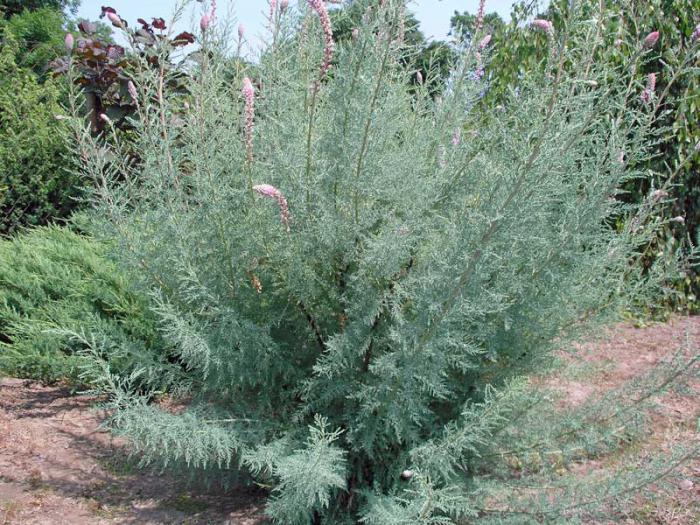

Shrubs can be replanted only in spring (when there are no leaves on the bush yet) and in autumn (roughly in October). It is advisable to leave a clod of earth on the roots, which will significantly increase the percentage of plant survival. The soil with which the planting hole should be filled can be prepared by combining it with peat in the same ratio; add wood ash there.
Tamarix and myrikaria are very similar in appearance to plants. Their only difference is that tamarix does not tolerate wintering well, and foxtail myrikaria is resistant to winter conditions; of course, there is an annual freezing of the roots of the plant, but this does not cause significant harm to the plant. Frosts under -40 ° C are not terrible for the plant - you don't even need to worry about additional shelter for it. Nevertheless, to protect myrikaria from frost, it is better to tie the shoots so that they do not break under the weight of wet snow. It is recommended to bend young bushes to the soil surface.
How myrikaria foxtail is propagated
Propagated by seeds and cuttings - winter and summer.
Seminal
the method is laborious, since the seed is characterized by poor germination. You can get the result only if you follow the rules of collection and storage. Be sure to carry out stratification at a temperature of 3-5 degrees C for about 4 days. This procedure increases the germination rate up to 94%.
Cuttings
, harvested in early spring before the buds awaken, are planted in containers with soil composed of equal parts of sand, humus and peat. In the summer, when the plant blooms, cuttings are harvested from shoots located closer to the ground. They are rooted in a garden bed under cover of a glass jar, a bottle of transparent plastic or film. In good conditions, 100% of the cuttings take root.
Mirikaria is surprisingly resistant to disease, and pests bypass it. It is beautiful both in and on the bank of an artificial pond, and as the center of the composition in a flower bed. Invite her to your garden and you will have something to surprise your guests.
Landscape design ideas: video
Growing myrikaria from seeds


Myrikaria seeds photo
The shrub propagates by seeds, cuttings and dividing the bush.
It is necessary to follow the rules for storing seeds so that they remain viable. Place them in an airtight, waterproof container, keep at moderate temperatures in a dry room. Planting is carried out the next year.
- Before planting, the seeds are stratified for a week: keep the seeds in a refrigerator with a temperature of 3-5 ° C. Stratification will ensure seed germination by more than 95%. Without this procedure, about a third of the seeds will sprout.
- Seeds are sown in boxes on top of the substrate, it is not necessary to deepen into the soil or sprinkle it with earth. Use the bottom method of moistening the soil through the sump. The seeds will hatch in a couple of days and small roots will appear.
- After about a week, an aerial shoot is formed.
- When the seedlings grow a little, they are planted in separate pots for growing.
- After the end of the frost, according to the established heat, plant the matured plants in the garden, but remember that even the slightest frost can destroy the seedlings.
Meet the garden "fox's tail"
This is a perennial deciduous shrub from the Tamarisk family (or Tamarix), the shape of the leaves of which resembles needles.
The plant can be recognized by:
- elongated yellow-brown, non-woody branches, growing up to 2 meters in height (and the bush spreads out 1.5 meters in width, since up to 20 shoots are quickly expelled from one root);
- scaly green (slightly bluish) leaves, completely covering each shoot;
- spike-shaped pink inflorescences.
This unpretentious plant looks rustic, but it winters very well, even if the frosts are strong, so myrikaria is an ideal solution for summer cottages for busy people.
The closest "sister" of the fox-tail can be called the Daurian myrikaria. Here is her photo for comparison:
In the wild, the "fox's tail" can be seen near rivers, in the mountains or forests of the Far East, Siberia, Kazakhstan, China. It grows well on rocky soils. In addition, the bush is not afraid of pests and typical flower diseases.
You will see more photos of this worthy plant here:
When this plant blooms
Flowering begins in May and ends as early as September.
Flowers in inflorescences do not bloom all at once, but in turn: first the lower ones, then the middle ones, and, finally, the tip of the inflorescence blooms. During this time, it significantly stretches in length, resembling a fluffy fox's tail (hence the name).
An even greater resemblance to the tail of an animal in a plant occurs in September, during the period of seed ripening - they slightly resemble dandelion seeds, since they also have fluffy "parachutes".
Like flowers, seeds ripen one at a time. They are located in a fluffy pyramidal box.
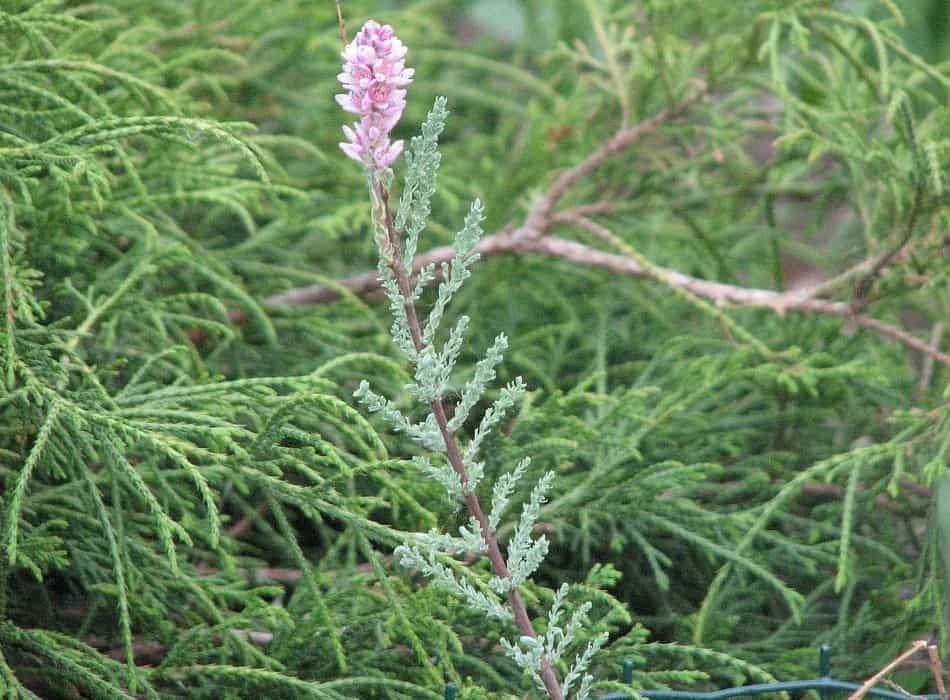

Use in garden design
Myrikaria foxtail is an excellent solution for any garden. Blooming ephedra looks good both alone and in group plantings.
It is planted near fountains, decorative reservoirs and lakes. It goes very well with conifers and deciduous plants, as well as shrubs, flowering pink and red shades.
Fox-tailed myricardia can be a bright decoration for any garden composition.
Fruits, vegetables, berries on the site are just wonderful, all their own and tasty. But I want to please the eye with an elegant and blooming flower bed. In recent years, the selection of various decorative flowering crops in specialized stores is huge, which is not there! And I want to buy something interesting and unusual for the site. I recommend that you purchase myrikaria. It compares favorably with other plants with silvery-gray leaves, blooms for 2-3 months, and the flowers exude a pleasant aroma.
A little about myrikaria
Mirikaria is a shrub with small scaly leaves with reddish-brown or yellow-brown shoots. This perennial plant came to us from Asia. Almost the entire area from Altai to Tibet is considered its homeland, but it is especially often found on the Mongolian and Chinese plains. For landscaping areas, 2 types of myrikaria are most often used (in total, there are about a dozen of them):
Daurskaya
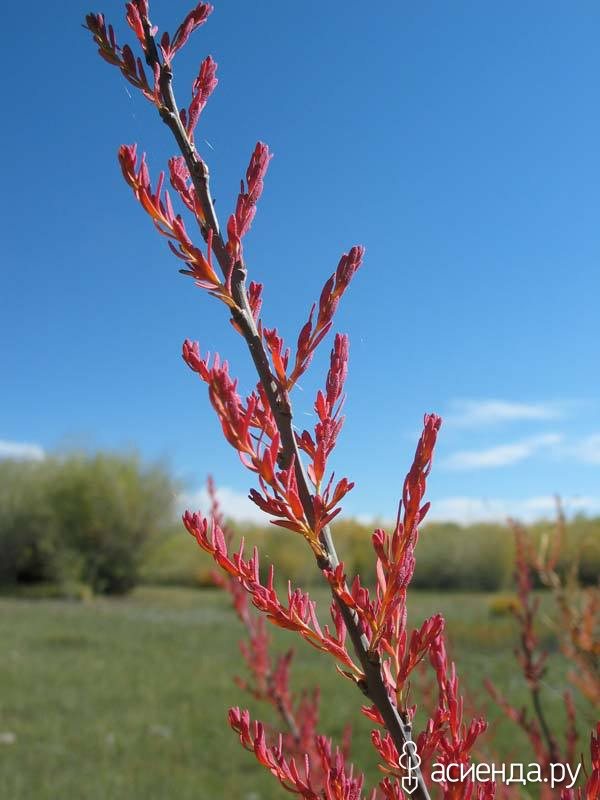

Foxtail (foxtail)
Their main difference lies in the arrangement of the peduncles: in the foxtail inflorescences they are located at the top of the branches, and in the Daurian inflorescences on the lateral branches. Mirikaria is very fond of light and wet areas, which will need to be taken into account when choosing a place to plant it. It tolerates pruning well, easily and quickly recovers after harsh winters, even if it had to be "cut" completely, leaving only a stump. The flowering of myrikaria begins around mid-May and lasts for 2-3 months, the flowers do not open all at once, but in turn, flowering begins from the lower branches and gradually moves to the upper branches.
Planting and caring for myricaria
Mirikaria is perhaps the best plant for those who do not like to take care of plants, but at the same time want their site to please the eye with beauty. This plant is extremely unpretentious, it is not susceptible to various diseases, and garden pests do not like it.In addition, it easily tolerates heat, even at a temperature of 40 degrees Celsius, it grows calmly, and cold, without freezing to the ground. To plant this ornamental shrub, you need to choose a bright place, but if possible shaded, with slightly acidic or neutral soil, preferably a peat substrate, but at the same time it grows well on fertile garden soil or on loamy soil. Mirikaria is very fond of moisture, but easily withstands drought, requiring only poor watering - about 10 liters per 1 bush for 10-14 days. But if the soil moisture is regular and sufficient, then the shrub will grow faster and bloom more actively. During the spring-summer period, it is necessary to feed 1-2 times with special fertilizers for heather plants. In addition, annually in the spring, it is advisable to mulch with humus or peat, then the shrub will delight you with a more saturated color of leaves and flowers.
Pruning
Mirikaria needs constant pruning. If you do not carry out this simple procedure, then over time, after 7-9 years, the shrubs will simply become stiff and lose their beauty and originality. Therefore, do not neglect this operation. You need to prune 2 times a year: in spring and autumn. Spring pruning will help get rid of frozen and dead twigs, and autumn pruning will help form a shrub of the desired shape.
Reproduction
Propagated by myrikaria seeds, cuttings and dividing the bush. The last two methods are optimal. When propagating by cuttings, it is necessary to cut off branches about 20-25 centimeters long during the entire vegetative period, then immerse them in growth stimulants for 2-3 hours and plant them in any container. Rooting is pretty fast. But in the first year, it is better not to plant young growth in open ground, since it does not tolerate wintering in open ground. And in the second year, you can safely leave in a permanent place without fear of death. When multiplying by seeds, it is desirable to stratify the seeds, this will increase their germination rate up to 95%. This operation is not necessary, but then the germination rate will be approximately 30-35%. Seeds are scattered over the surface of the ground in a box, without sprinkling them with soil. Water gently, in drops or with a spray bottle. Roots appear in 2-3 days, and sprouts in 7-8 days. After warming, the seedlings are planted in open ground.
I have long dreamed of making a real "wild" garden. Not with weeds, of course, but so that it does not turn out to be "licked" or artificial, but looks like a well-groomed forest.
Therefore, we do not have paved paths, alpine hills and pretentious rose bushes, but there is rockery, fragrant juniper thickets, paths lined with varietal hosts, and flowering thickets of myrikaria in the background.
This is a perennial deciduous shrub from the Tamarisk family (or Tamarix), the shape of the leaves of which resembles needles.
The plant can be recognized by:
- elongated yellow-brown, non-woody branches, growing up to 2 meters in height (and the bush spreads out 1.5 meters in width, since up to 20 shoots are quickly expelled from one root);
- scaly green (slightly bluish) leaves, completely covering each shoot;
- spike-shaped pink inflorescences.
This unpretentious plant looks rustic, but it winters very well, even if the frosts are strong, so myrikaria is an ideal solution for summer cottages for busy people.
The closest "sister" of the fox-tail can be called the Daurian myrikaria. Here is her photo for comparison:
In the wild, the "fox's tail" can be seen near rivers, in the mountains or forests of the Far East, Siberia, Kazakhstan, China. It grows well on rocky soils. In addition, the bush is not afraid of pests and typical flower diseases.
You will see more photos of this worthy plant here:
When this plant blooms
Flowering begins in May and ends as early as September.
Flowers in inflorescences do not bloom all at once, but in turn: first the lower ones, then the middle ones, and, finally, the tip of the inflorescence blooms. During this time, it significantly stretches in length, resembling a fluffy fox's tail (hence the name).
An even greater resemblance to the tail of an animal in a plant occurs in September, during the period of seed ripening - they slightly resemble dandelion seeds, since they also have fluffy "parachutes".
Like flowers, seeds ripen one at a time. They are located in a fluffy pyramidal box.
Varieties of myrikaria with photos and names
Myricaria dahurian long-leaved Myricaria longifolia
Distributed in the south of Siberia and Altai. Young shoots in the first year of life are covered with a yellowish-green bark, which turns brown over the years. The foliage is narrow, 5-10 mm long, 1-3 mm wide. The leaves are oblong or ovoid, painted in a gray color, the upper part of the foliage is covered with small glands.
Inflorescences are formed on lateral (older) and apical (one-year-old) shoots. They are simple in form or more complex, branched. At first, the peduncles are shortened, but lengthen with the opening of the buds. The bract is up to 6 mm in diameter; it has a small calyx up to 3-4 cm in diameter. Petals are pink, oblong, 5-6 mm long, about 2 mm wide. The capitate stigma of the ovary is decorated with half-fused stamens. The seed box is tricuspid, elongated, filled with elongated seeds up to 1.2 cm long with a slightly pubescent axis.
Myricaria foxtail or foxtail Myricaria alopecuroides
Most common in Western Europe, the Far East and Central Asia. The plant is a low shrub with straight and ascending lateral shoots, leaves are alternate, fleshy, scaly. The color of the foliage is silver with a blue tint.
From mid-May until the end of summer, brushes of pink inflorescences flaunt on the tops of the stems. Flowers begin to open from below, gradually covering the peduncle densely, which can lead to the bending of the stem in an arc. Before the opening of the buds, the length of the peduncle is up to 10 cm, and it looks like a dense cone, as it blooms, it lengthens up to 40 cm, becoming looser.
Fruit ripening begins in autumn. Due to the whitish pubescence of the seeds at the ends of the branches, the large shoot becomes like a fox's tail with a lush light tip. It was this feature that gave such a name.
Myricaria germanica
Blooms in June-July, very decorative thanks to its bluish branches, similar to spruce. It is widely used in folk medicine as a hemostatic agent, especially for gynecological diseases. Needs shelter for the winter at a young age.
Myricaria rosea Myricaria rosea
Herbaceous plant or shrub with small needle-like leaves and large pink inflorescences, somewhat massive compared to the twigs.
Mirikaria is the new name in the front garden
The vast majority of plants in the Russian flora have pure green leaves. But occasionally there are species with bluish, blue and gray shades in color. They are especially interesting for an ornamental garden, as they diversify its color scheme, contrastingly standing out against the general background. Designers are especially fond of these types, it is no coincidence that steel-gray wormwood and "lamb's ears", blue spruces and junipers, gray fescue and elimus were prescribed in the gardens. The plant that will be discussed below seems strange from all sides: the color and shape of the leaves, the unusual shape of the inflorescences, the nature of growth and the shape of the bush, and even by its very name - myrikaria.
The strangeness of the myrikaria in its unusual appearance. It seems that this is not a flowering, but an exotic coniferous plant. But then it suddenly blooms, and again a surprise - the first individual flowers, gradually stretching out into long inflorescences, turn into fiery fox tails.Botanists called this shrub just that - myricaria alopecuroides.
In total, there are 10 types of myrikaria, 6 of them are found within the CIS, the rest in the regions of Asia adjacent to our borders. All of them are shrubs and semi-shrubs belonging to the Tamarix or comb family (Tamaricaceae). In Russian ornamental gardens, foxtail myrikaria is most often found, it is also German.


In nature, the range of this species extends in the south of Russia from the steppe belt of Siberia to the south of the European part, spreading further into Central Asia and Western Europe. In our conditions, myrikaria grows low, up to 1 m, spreading - up to 1.5 m, a bush consisting of 10-20 low-branched whip-like shoots emanating from the root. The leaves of myrikaria are very small, having the appearance of fleshy greenish-blue scales, densely clinging to the shoots. The color and texture of the leaves effectively distinguish myrikaria against the background of ordinary greenery, making it attractive throughout the growing season - from early May to October. From mid-May, the additional decoration of the bushes is pinkish flowers that appear on the tops of the axial and then axillary shoots. The flowers are very small, but gradually growing and molding to each other, they gradually turn into dense spike-shaped inflorescences up to 40 cm long. The flowering of myrikaria lasts more than two months, sometimes capturing the beginning of August.
Mirikaria grows well and winters steadily in central Russia. A slight freezing of the ends of the branches is observed almost every year, but this does not in the least affect her appearance. It is noteworthy that the ends of the shoots of this species, even in nature, never become lignified, which is why scientists consider it a half-shrub. Mirikaria is light and moisture-loving, rather undemanding to soil fertility. At the same time, the most favorable places for it are places open to the sun with moist, well-drained fertile loams. If a soil substrate is specially prepared, then a mixture of medium or light loam with peat in a 1: 1 ratio may be suitable, for example. The planting pit is dug about 50x50x50cm in size, and filled with the prepared substrate. It is also useful to add wood ash (about 300 g per place) or mineral NPK mixture (50-70 g) there. Plants tolerate a transplant with open roots only in a leafless state - in spring to early May, in autumn from mid to late October. With a lump of earth, and even more so in a container, the transplant is always successful.
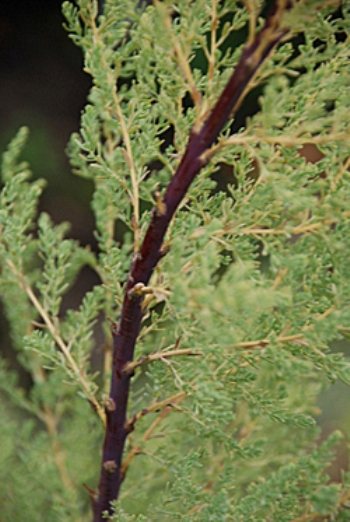

Proper care transforms the appearance of any plant and myrikaria is a vivid proof of this. It responds to fertilization and watering with active growth, fresh leaf color, and abundant flowering. The main fertilizer, in the form of humus or compost (approximately from a bucket to a bush), is shown to be applied in the spring until mid-May under a shallow embedment in the root zone. After half a month, it is good to mulch the foot of the bushes with a moisture-absorbing mulch containing humus: peat, crushed tree bark chips, loose humus, etc. The meaning of this action is to stabilize the moisture regime of the upper soil layer, at the same time it will attract earthworms and improve aeration. During the summer (in June-July) it is useful to make one or two liquid top dressing with mullein infusion (1:10) or fermented herb infusion prepared in the same proportion. Let me remind you that for this, two buckets of manure or four tightly filled buckets of grass are placed in a 200-liter barrel of water and insisted for two weeks. During this time, the nutrients pass into a state that is digestible for plants. The infusion is consumed in the amount of 2 liters per bush.
In dry periods, myrikaria should be watered with a frequency of once every 7-10 days, and between waterings, the near-stem circles are shallowly loosened, which also enhances nutrition, like watering itself.
Pruning of myrikaria is carried out at the beginning of leaf blooming, when winter lesions are more clearly visible.Frozen shoots are shortened to healthy wood or cut into a ring, guided, first of all, by considerations of decorativeness. At the same time, branches that protrude far beyond the crown are shortened.
The natural spreading of the crown does not always suit the myrikaria, and the compactness and density, on the contrary, simply transform it. This can be achieved by shaping and cutting. Mirikaria even tolerates significant pruning, but it is more expedient to form the bushes gradually, starting this process from a very young age. At first, they only pinch the green ends of the shoots, limiting them to a length of about half a meter. This can be done almost the entire season, as they grow, but end from the beginning of September, giving the plants the opportunity to prepare for the cold weather. Step by step, the crown of the bushes will thicken more and more, acquiring the appearance of a dense hemisphere or a pillow of an attractive bluish-blue color.
The bushes formed in this way are very interesting in a single planting on a contrasting carpet background of purple tenacious, stonecrop, loosestrife "Aurea", Fortchun's euonymus, periwinkles, etc. A similar plot will look good in the entrance area of a country house, city cottage, in front of the office of a private company. By the way, the urban atmosphere of myrikaria does not harm at all. In landscaping, it can be planted as edging on large green islands of city auto-interchanges, with curbs along park alleys open to the sun. She matches the neighborhood of fairly large stones, tightly trimmed, she will not spoil with herself the compositions in the Japanese spirit.
Similar to an ephedra, "strange" myrikaria will organically weave into a coniferous garden, organized in contrasting combinations. If you need to decorate a small slope, then myrikariya, who loves moisture, it is better to take a place at its foot, planting it in a dense clump of several plants.
Smirnov Alexander Dmitrievich
Plants for the garden by mail: adonis, actinidia, barberries, hawthorns, blueberries, spruce, honeysuckle, cranberries, currants, hydrangeas, junipers, roses, spireas, tamariks, thuja, hosts, chubushniki and much more. Inexpensive, because we grow ourselves. Winter hardy and reliable, because it has been tested for many years. Experience of sending in Russia since 1995. Catalog in your envelope, on E-mail or on the website. 600028, Vladimir, 24 passage, 12, Smirnov Alexander Dmitrievich
Myricaria has scaly, small leaves, like heather.
The genus Mirikaria has about 10 species growing in Europe and Asia.
Mirikaria is a shrub with yellow or reddish-brown shoots and ordinary, scaly leaves that completely cover the shoots. The flowers of this shrub have a long bracts, the fruit is a box with seeds, equipped with hairy awns at the very top.
Mirikaria is a light-loving and moisture-loving shrub. Gives good growth from the stump. Tolerates haircuts well. The shrub is decorative with its extraordinary appearance during flowering and fruiting. For decorative purposes, it is used in single planting and hedges.
Reproduction methods
If we are talking about the seed method of reproduction, then first of all it is necessary to choose the right seed material. Incorrect storage conditions can lead to the loss of the ability to ascend. Seeds should be stored in sealed containers in moderate temperature conditions throughout the year, after which they are ready for sowing. Also, a stratification procedure is required at a temperature not higher than three to five degrees.
Sowing is carried out in containers, scattering the seed on the surface of the soil. Moisturizing is done in a drip or ascending manner. As a rule, after two to three days, the seed will give a root, and the sprout will hatch above the surface in a week. When the warm period comes, you can transplant seedlings into open ground.
A more effective way of propagation is vegetative, by cuttings or dividing the bush.Cuttings can be obtained from old or young shoots that root easily throughout the growing season. Cut cuttings must be placed in any growth stimulator for a while, and then planted in prepared soil. You should know that a young plant is very sensitive to probable frost, therefore, planting should be done exclusively in the warm season.
Choosing a landing site
The place for planting ornamental shrubs should be sunny and sheltered from the winds. In partial shade, the plant will also feel good, but the flowering will not be very abundant, and the flowers will be dull. To the soil bush not picky... But the best option for planting would be drained loam. Mirikaria tolerates slight flooding and is also a drought tolerant shrub.
Important! The root system of myricardia is small, weakly rooted, therefore, on sandy stones, the bush will suffer from drying out of the upper layers of the soil.
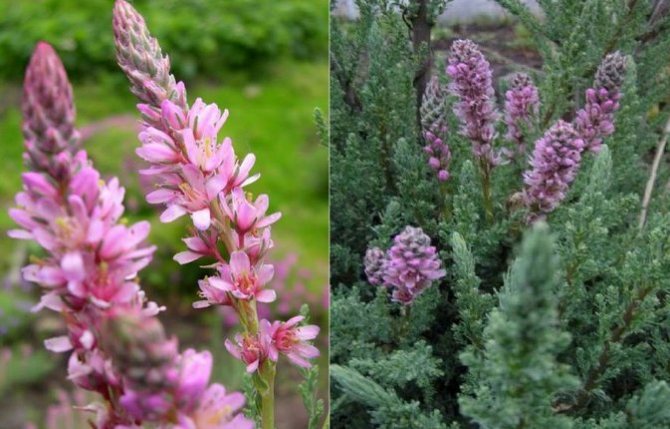

Pruning and shaping the crown of myrikaria
Pruning is done at the beginning of leaf blooming; frozen shoots are shortened to healthy wood. Sometimes the plant, due to the shortened shoots that protruded beyond the crown, takes on a decorative neat appearance. By the way, the compactness of myrikaria, achieved by pruning, absolutely transforms the shrubs.
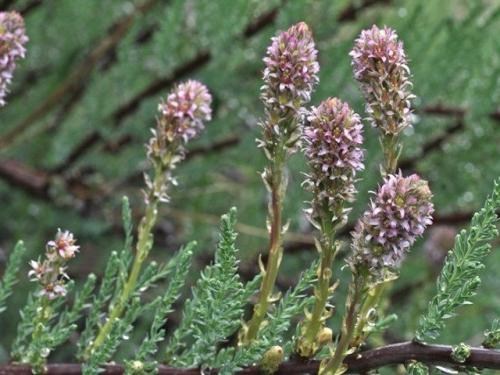

It is advisable to start the process of forming an attractive crown from a young age of the plant, first pinching only the green tips of the stems and limiting them in length to half a meter. This can be done throughout the season, as it grows back. By September, the pruning process should be stopped to allow the plant to prepare for the winter cold. Thus, every year the crown of the bush will become more and more magnificent, turning the plant into a dense hemisphere of a bluish-blue color. Such bushes in a single planting, formed with sincere love, will stand out in an original way against a green carpet background.
Mirikaria as a decorative element of the garden composition
Mirikaria can be successfully planted in urban environments, using it as edging curbs, park alleys and green areas of interconnections. Foxtail Mirikaria, planting and caring for which distinguishes it favorably from wild-growing specimens, looks original against the background of ponds and large stones, enlivening their silent neighborhood; the plant organically fits into a coniferous garden, likening to evergreen shrubs. The myrikariya group can be used to decorate a small slope by setting aside a place at its foot.
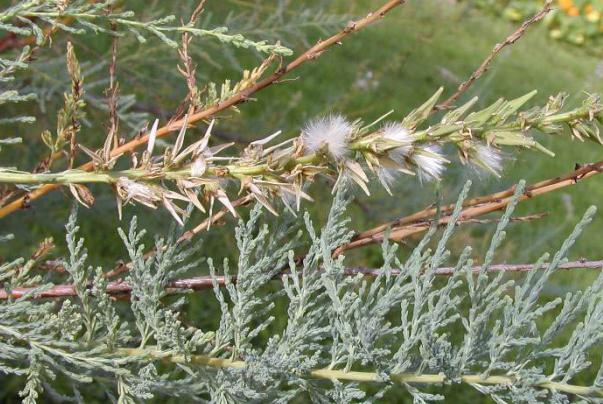

Not many gardeners understand the incredible beauty of this bush. Often he is given a place somewhere in an unremarkable corner of the garden. In fact, foxtail myrikaria, planting and caring for which is not difficult, can become a bright center of an attractive garden composition.
Fox-tailed myrikaria: when is it better to plant and how to properly care
Myrikaria foxtail attracts the attention of gardeners with its tallness, about two meters, relative unpretentiousness in care and, most importantly, the original scaly foliage of a silvery color with a blue tint. The bizarre crown shape and elongated pink inflorescences have brought this perennial deciduous shrub into the category of the most popular crops for landscape design.
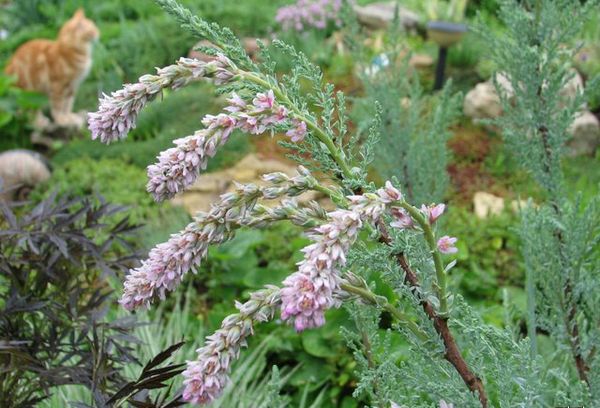

An ornamental plant is not afraid of low temperatures and quickly adapts to the environment. By creating favorable conditions for growth of the fox-tailed myrikaria, following the planting technology and providing it with proper care, you can grow a luxurious spreading decoration for your garden.
Correct care
Mirikaria demonstrates resistance to possible disease and pest damage. An adult plant can easily withstand severe frosts, as well as strong summer heat.
The soil composition can be normal garden soil, but the medium should be neutral or slightly acidic. Drought resistance is the main "horse" of a shrub that can withstand extreme heat. Even during this period, enough watering will be one bucket per adult bush once every ten days. On the other hand, Mirikaria can easily endure waterlogging and stagnant water without consequences.
Regular mulching of the soil using organic matter is recommended, which contributes to the saturation of the foliage with colors. During the growing season, it is enough to feed the plant once or twice, using universal fertilizers for suitable crops.
It is better to choose a place for planting a little shaded, despite the good resistance to sunlight, which can still harm young plants.
Myricaria care
A perennial crop is highly immune to various pests and diseases. Calmly tolerates negative temperatures up to -40 degrees and high up to +40.
Watering. A perennial normally tolerates drought, develops even with poor watering, but it will grow stronger and bloom on moist soil. If there is no rain, then the bush is watered once every two weeks at the rate of 10 liters of water per plant. The culture is able to withstand the reverse drought and attack: an excess of moisture and temporary flooding of the site.


Top dressing. If you mulch the soil every year with organic fertilizer or peat, then there is no need for frequent feeding. Thanks to these compositions, the color of the petals and leaves becomes more pronounced, bright. For a season, 1-2 additional fertilizing with a universal fertilizer intended for heather crops is enough.
Pruning. Over time, the bush grows stiff, and by the age of 7-8 it almost completely loses its decorative effect. To keep the plant in an attractive shape, sanitary and anti-aging pruning is carried out in the fall and spring. Dried, damaged and old shoots are subject to removal.
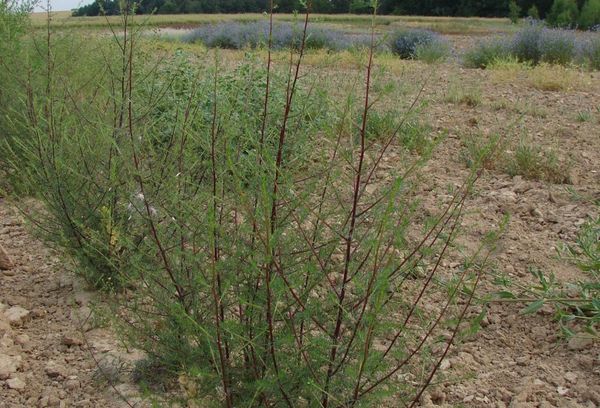

Wintering. The spreading foxtail myrikaria is very afraid of gusts of wind, so it is planted in calm areas. Before the arrival of winter, the plant should be tied up to protect it from fractures due to snow drifts. Young plants are often bent to the ground.
Myrikaria foxtail is an amazingly beautiful perennial that does not cause difficulties when growing, a little attention and accuracy when planting is enough.
Mirikaria: reproduction
Propagation of myrikaria is carried out by cuttings and seeds, when collecting them, it is required to observe storage conditions, because they quickly lose their germination. Before sowing, seeds are kept in a refrigerator for 1 to 5 days at a temperature of 3-5 degrees, which provides them with an estimated germination rate of up to 95%. Without the use of stratification (keeping the seed at a certain temperature, ensuring the acceleration of germination), the germination of the plant will not exceed 30%.
The most convenient is propagation by cuttings, which must be prepared in the middle of summer, during the period of mass flowering of the plant. On the bush, the stems of the lower part of the plant are cut off and planted in containers, in prepared soil, consisting of peat, humus and sand, taken in equal proportions.
Mirikaria Daurian landing and leaving. Planting foxtail myrikaria: plant care, photo
The vast majority of plants in the Russian flora have pure green leaves. But occasionally there are species with bluish, blue and gray shades in color. They are especially interesting for an ornamental garden, as they diversify its color scheme, contrastingly standing out against the general background. Designers are especially fond of these types, it is no coincidence that steel-gray wormwood and "lamb's ears", blue spruces and junipers, gray fescue and elimus were prescribed in the gardens. The plant that will be discussed below seems strange from all sides: the color and shape of the leaves, the unusual shape of the inflorescences, the nature of growth and the shape of the bush, and even by its very name - myrikaria.
The strangeness of myrikaria in its unusual appearance. It seems that this is not a flowering, but an exotic coniferous plant. But then it suddenly blooms, and again a surprise - the first individual flowers, gradually stretching out into long inflorescences, turn into fiery fox tails. This bush was called by botanists - myricaria foxtail (Myricaria alopecuroides)
.
In total, there are 10 types of myrikaria, 6 of them are found within the CIS, the rest in the regions of Asia adjacent to our borders. All of them are shrubs and semi-shrubs belonging to the Tamari caceae family. In Russian ornamental gardens, foxtail myrikaria is most often found, it is also German.
In nature, the range of this species extends in the south of Russia from the steppe belt of Siberia to the south of the European part, spreading further into Central Asia and Western Europe. In our conditions, myrikaria grows low, up to 1 m, spreading - up to 1.5 m, a bush consisting of 10-20 low-branched whip-like shoots emanating from the root. The leaves of myrikaria are very small, having the appearance of fleshy greenish-blue scales, densely clinging to the shoots. The color and texture of the leaves effectively distinguish myrikaria against the background of ordinary greenery, making it attractive throughout the growing season - from early May to October. From mid-May, the additional decoration of the bushes is pinkish flowers that appear on the tops of the axial and then axillary shoots. The flowers are very small, but gradually growing and molding to each other, they gradually turn into dense spike-shaped inflorescences up to 40 cm long. Myrikaria bloom lasts more than two months, sometimes capturing the beginning of August.
Mirikaria grows well and winters steadily in central Russia.
A slight freezing of the ends of the branches is observed almost annually, but this does not in the least affect her appearance. It is noteworthy that the ends of the shoots of this species, even in nature, never become lignified, which is why scientists consider it to be a half-shrub. Mirikaria is light and moisture-loving, rather undemanding to soil fertility. At the same time, the most favorable places for it are places open to the sun with moist, well-drained fertile loams. If the soil substrate is specially prepared, it may be suitable, for example, a mixture of medium or light loam with peat in a 1: 1 ratio. The planting pit is dug about 50 * 50 * 50cm in size, and filled with the prepared substrate. It is also useful to add wood ash (about 300 g per place) or mineral NPK mixture (50 -70 g) there. Plants tolerate a transplant with open roots only in a leafless state - in spring to early May, in autumn from mid to late October. With a lump of earth, and even more so in a container, the transplant is always successful.
Proper care transforms the appearance of any plant and myrikaria is a vivid proof of this.
It responds to fertilization and watering with active growth, fresh leaf color, and abundant flowering. The main fertilizer, in the form of humus or compost (approximately from a bucket to a bush), is shown to be applied in the spring until mid-May under a shallow embedment in the root zone. After half a month, it is good to mulch the foot of the bushes with moisture-absorbing mulch containing humus: peat, crushed tree bark chips, loose humus, etc. The meaning of this action is to stabilize the moisture regime of the upper soil layer, at the same time it will attract earthworms and improve aeration. During the summer (in June-July) it is useful to make one or two liquid top dressing with mullein infusion (1: 10) or fermented herb infusion prepared in the same proportion. Let me remind you that for this, two buckets of manure or four tightly filled buckets of grass are placed in a 200-liter barrel of water and insisted for two weeks. During this time, the nutrients pass into a state that is digestible for plants. The infusion is consumed in the amount of 2 liters per bush.
In dry periods, myrikaria should be watered with a frequency of once every 7-10 days, and between waterings, the near-trunk circles are shallowly loosened, which also enhances nutrition, like watering itself.
Pruning
myrikaria are carried out at the beginning of leaf blooming, when winter lesions are more clearly visible. Frozen shoots are shortened to healthy wood or cut into a ring, guided, first of all, by considerations of decorativeness. At the same time, branches that protrude far beyond the crown are shortened.
The natural spreading of the crown does not always suit the myrikaria, and the compactness and density, on the contrary, simply transform it. This can be achieved by shaping and cutting. Mirikaria even tolerates significant pruning, but it is more expedient to form the bushes gradually, starting this process from a very young age. At first, only pinch the green ends of the shoots, limiting them to a length of about half a meter. This can be done almost the entire season, as they grow, but end with the beginning of September, giving the plants the opportunity to prepare for the cold weather. Step by step, the crown of the bushes will thicken more and more, taking on the appearance of a dense hemisphere or a pillow of an attractive bluish-blue color.
The bushes formed in this way are very interesting in a single planting on a contrasting carpet background of purple, monetary "Aurea", Fortune, etc. A similar plot will look good in the entrance area of a country house, city cottage, in front of the office of a private company. By the way, the urban atmosphere of myrikaria does not harm at all. In landscaping, it can be planted as edging on large green islands of city auto-interchanges, with curbs along park alleys open to the sun. She suits the neighborhood of rather large stones, tightly trimmed, she will not spoil with herself the compositions in the Japanese spirit.
Similar to an ephedra, "strange" myrikaria will organically weave into a coniferous garden, organized in contrasting combinations. If you need to decorate a small slope, then myrikariya, who loves moisture, it is better to take a place at its foot, planting it in a dense clump of several plants.
Myrikaria foxtail is an interesting plant for landscape design, although it cannot boast of a variety of varieties. Some gardeners only saw her in the photo, although both cultivation and maintenance require a minimum of effort. It is not difficult to propagate it, the main thing is to choose a successful landing site. Read about all this in the article.
Fox-tailed Mirikaria: breeding features
Planting and caring for myrikaria is not difficult. An unpretentious shrub can be propagated in several ways:
- seeds;
- cuttings;
- branch overgrowth.
Seed breeding method
This variant of breeding myrikaria is less popular than cuttings. Florists consider it ineffective and overly time consuming. Even the storage of seeds is difficult, since they require sealed packaging and a moderate temperature regime.
If the rules for storing seeds are not followed, they may lose germination.
In order to increase germination, the seed should be hardened for 5 days at a low temperature - about + 4 ° C. For seeds that have not undergone such hardening, the germination rate is no more than a third of the seed.
Planting seeds:
- Preparing a container for germinating seeds.
- Falling asleep with soil mixture.
- Sowing seeds (without falling asleep on top of the earth).
- Organization of drip irrigation.
When properly organized, the seeds will germinate in a few days. After the sprouts have grown, they can be transplanted into open ground.
Planting seeds in open ground should only be done in warm weather.
Breeding myrikaria with foxtail cuttings is an effective way of breeding a dwarf shrub. It is carried out in the spring, before the buds begin to bloom.
Work order:
- Cut the cuttings 15 to 25 cm long.
- Prepare a soil mixture consisting of sand, peat, humus and soil. All components are taken in equal quantities.
- Cuttings are planted at an angle, leaving 3 buds above the surface.
For better rooting of cuttings, it is recommended to use a root formation stimulator before planting.
Rooted cuttings form new plants. For a climate in which frosts are present in winter, it is possible to leave new plants in the ground only in the second year in order to avoid freezing of the immature young myrikaria.
The first flowering after cuttings occurs two years later. The plant reaches full growth only 4-5 years after planting the cuttings. Since the plant is perennial, it does not need additional replanting.
Mirikaria is a spectacular plant suitable for landscaping. It organically fits into plant compositions, benefiting from the peculiarities of its colors. The fox-tailed myrikaria beautifully complements alpine slides, rockeries and artificial reservoirs.
Description of myrikaria
Mirikaria is a perennial that looks like heather and belongs to the Grebenshchikov family. Mirica is a word form of the Latin name for heather. The homeland of myrikariya is Asia, where it lives from Altai to Tibet, widely spreads on the Mongolian and Chinese plains. It grows on plateaus, uplands, climbs to a height of about 1.9 km above sea level.
The shrub has branched shoots of a reddish or yellow-brown hue with miniature scaly leaves. In a temperate climate, sprawling shrubs reach a height of 1-1.5 m, in their natural habitat there are giants up to 4 m.Garden representatives grow up to 1.5 m wide.
The bush consists of 10-20 ascending main shoots, they are smooth, woody. The lateral processes are covered with small fleshy leaves, painted in a bluish-green color. The growing season begins in May and lasts until the onset of frost. Even without inflorescences, the bush serves as an interesting decoration for gardens and front gardens.
When does myricaria bloom?
The flowering of marikaria begins in mid-May and lasts about two months. Delicate buds open gradually. First, they open on the lower shoots adjacent to the ground, by the end of summer, the tops are covered with flowers. Each flower lives for 3-5 days. A spike-shaped inflorescence appears on long, forty-centimeter peduncles. Small pink or purple flowers densely cover the brushes.
At the end of the flowering stage, seeds begin to ripen, collected in an elongated box in the shape of a pyramid. Small seeds are covered with whitish pubescence.
Mirikaria in landscape design


Mirikaria is perfect for decorating artificial and natural reservoirs. It is used solo or in planting in groups in flower beds. Preferred neighbors will be deciduous and coniferous dark green crops that look beautiful in rose gardens.
The plantings look original together with plants that have a purple color, for example, a. Ground covers with blue flowers are planted as the lower tier - perfect. Luxurious and Aurea with yellow leaves will perfectly complement the composition.

